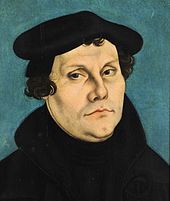Mit Fried und Freud ich fahr dahin, BWV 125
Johann Sebastian Bach composed the cantata Mit Fried und Freud ich fahr dahin (German: [mɪt ˈfʁiːt ʔʊnt ˈfʁɔʏt ʔɪç ˈfaːɐ̯ daˈhɪn]; "With peace and joy I depart"),[1] BWV 125,[a] for use in a Lutheran service.In the third movement, Bach sets the single lines from the hymn's second stanza differently from the commentary in the librettist's words, but unifies both elements by a continuous "motif of joy" in the accompaniment.In Leipzig, cantata music was expected on Sundays and on feast days, except during the "silent periods" ("tempus clausum") of Advent and Lent.[13] He finally composed Wär Gott nicht mit uns diese Zeit, BWV 14, for the Fourth Sunday after Epiphany in 1735.[2] When Luther wrote his hymn on Simeon's canticle ("With peace and joy I depart in God's will"),[17] he devoted one stanza to each of the four verses of the biblical text.'[20] (Als wolt er [Simeon] sagen / Gott sey lob und danck / daß ich diesen Tag erlebet habe / ich will nun gerne sterben / nun soll mir der Tod lieblich seyn / denn es ist erfüllet / das mir verheissen war.The second occasion was in 1724, in the Purification cantata, Erfreute Zeit im neuen Bunde, BWV 83, which he closed with the fourth and final stanza, "Es ist das Heil und selig Licht".Bach scored the work for three vocal soloists (alto (A), tenor (T) and bass (B)), a four-part choir, and a Baroque instrumental ensemble: horn (Co) to support the chorale tune sung by the soprano in the outer movements, flauto traverso (Ft), oboe (Ob), oboe d'amore (Oa), two violins (Vl), viola (Va), and basso continuo (Bc).[28][29] The title page of the original parts reads: "Festo Purificat: Mari[ae] / Mit Fried und Freud ich fahr dahin etc.The opening chorus, "Mit Fried und Freud ich fahr dahin in Gottes Willen" (With peace and joy I depart in God's will),[1] begins with a concertante ritornello, in which the flute and oboe play opposed to the strings.In accordance to the text, "sanft und stille" (calm and quiet) and "der Tod ist mein Schlaf worden" (death has become my sleep), they are performed softly (piano), in homophony, chromatic, and modulating to distant keys.[34] Dürr notes the movement's "extremely dense, highly expressive texture"[34] with motifs independent from the hymn tune but derived from its beginning.[35] The alto aria, "Ich will auch mit gebrochnen Augen nach dir, mein treuer Heiland, sehn.""[34] The bass recitative begins with a thought of the librettist, "O Wunder, daß ein Herz vor der dem Fleisch verhaßten Gruft und gar des Todes Schmerz sich nicht entsetzet!"[1] The text continues with the beginning of the hymn's second stanza, "Das macht Christus, wahr' Gottes Sohn, der treue Heiland" (Christ, God's true son, does this, the loving Savior).This is the work of Christ, God's true son, the faithful saviour, whom you, Lord, have allowed me to see and made known that He is our life and salvation in trouble and in dying.)"[16] Jones comments that the trio sonata of two violins and continuo which accompanies the voices "in its vigour and fluency perhaps represents the powerful, continuous sound to which the text refers."[35] The alto expresses in a secco recitative "O unerschöpfter Schatz der Güte" (O uncreated hoard of goodness),[1] which Hofmann calls a "concise theological analysis".[24] The closing chorale, "Er ist das Heil und selig Licht" (He is the salvation and the blessed light),[1] is a four-part setting of the hymn tune.


Chorale cantataJ. S. BachPurificationMit Fried und Freud ich fahr dahinMartin LutherLeipzigJohann Sebastian BachcantataLutheranPurification of MaryCandlemaschorale cantata cyclefeast daysliturgical yearThe gospel for the feast daypresentation of Jesus at the TempleSimeoncanticleNunc dimittisstanzasGottes Zeit ist die allerbeste Zeit, BWV 106his first Leipzig cyclelibrettistrecitativemovementschorale fantasiachoraleBaroque ensembleSt Matthew PassionThomaskantorThomanerchorThomaskircheNikolaikircheNeue KirchePeterskircheTrinitytempus clausumAdventfirst cantata cyclecycle of chorale cantatasLucas CranachProtestant reformermany hymnsChrist lag in Todes Banden, BWV 4Ach Gott, vom Himmel sieh dareinChrist unser Herr zum Jordan kamMeine Seel erhebt den HerrenAus tiefer Not schrei ich zu dirNun komm, der Heiden HeilandGelobet seist du, Jesu ChristChristum wir sollen loben schonErhalt uns, Herr, bei deinem WortChrist lag in TodesbandenEin feste Burg ist unser GottAlles, was von Gott geboren, BWV 80aBWV 80Wär Gott nicht mit uns diese Zeit, BWV 14strophicAndreas StübelThomasschuleGregorian chantMarianAnnunciationVisitationBook of MalachiGospel of LukeSecond ComingJohann WalterEyn geystlich Gesangk BuchleynariosoChristus, der ist mein Leben, BWV 95Erfreute Zeit im neuen Bunde, BWV 83Klaus Hofmanngrace of Godvesper servicefour-part choirBaroque instrumentalflauto traversooboe d'amoreviolinsbasso continuoNeue Bach-Ausgabetime signaturesAlfred DürrE minorB minorG majorPresentation at the templeritornellotripletsintervalcantus firmusDorian modehomophonychromaticmodulatingRichard D. P. Jonessarabandeappoggiaturascoloraturatrio sonataautograph scoreChristian Friedrich PenzelBach-Archiv LeipzigStaatsbibliothek zu BerlinWilhelm Friedemann BachJohann Andreas KuhnauAnton DiabelliBach-Gesellschaft AusgabeAlfred DörffelNew Bach EditionUwe WolfBreitkopfhistorically informed performancesHelmuth RillingFiguralchor der Gedächtniskirche StuttgartBach-Collegium StuttgartMarga HöffgenKurt EquiluzWolfgang SchöneHänsslerNikolaus HarnoncourtTölzer KnabenchorConcentus Musicus WienPaul EsswoodThomas Thomaschke